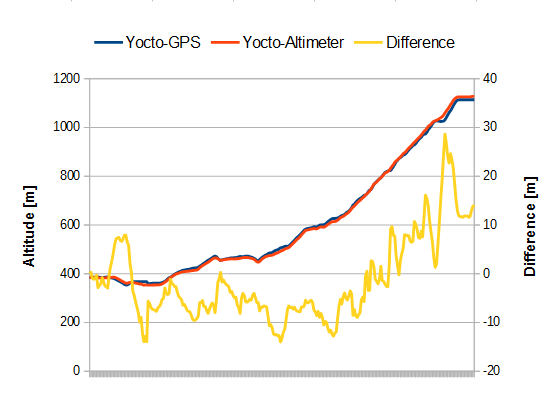 We have two modules that can compute the altitude: the Yocto-GPS and the Yocto-Altimeter. These two modules determine the altitude with two radically different methods. Lets have a look at the advantages and disadvantages of both.
We have two modules that can compute the altitude: the Yocto-GPS and the Yocto-Altimeter. These two modules determine the altitude with two radically different methods. Lets have a look at the advantages and disadvantages of both.
The Yocto-GPS is a GNSS (GPS and GLONASS satellites) signal receiver. It computes the current altitude from the GPS signals that the antenna receives. Obviously, this module enables you to know the latitude, the longitude, the ground speed, the direction, and the current time.
The Yocto-Altimeter is a barometric altimeter, which means that it uses the atmospheric pressure to compute the altitude of the sensor. On top of the altitude, the Yocto-Altimeter can also report ambient temperature.
Similarities
From a software standpoint, both modules provide an "altitude" function which you can use with the "YAltitude" class or with the "YAltitude.exe" tool. This means that if your application works with a Yocto-Altimeter, it works with a Yocto-GPS as well (and vice-versa).
Both modules have an embedded data logger which can store up to about 500'000 values. The data logger ensures that measures are not lost even if the application is stopped (for example because of a computer restart). There too, both modules are compatible because they use the same software interface to communicate with the data logger.
On paper, the Yocto-GPS looks inviting: on top of the altitude, the module enables you to locate its position in the 3 dimensions. And in most cases, one wants full positioning (latitude, longitude, and altitude). However, the Yocto-Altimeter has a number of advantages.
Accuracy
Computing the altitude from GPS signals is not very accurate. If the Yocto-GPS is able to locate you on a map with an accuracy of one meter and a half in a plain with a clear sky, expect errors of several tens of meters for altitude. The GPS needs a direct view with the satellites to determine its position. The more satellites it sees, the more accurate is the measure. If you are at the foot of a cliff or between buildings, the number of visible satellites diminishes greatly and so does the accuracy of the measure. Obviously, if you don't have a direct view of the sky (for instance inside a building), the GPS is simply not able to determine its position.
To demonstrate the difference between barometric and GPS altimeters, we conducted a little experiment. We recorded the altitude with a Yocto-GPS and a Yocto-Altimeter while traveling from Bernex, a little village near Geneva, to the Salève, a mountain nearby. As you can see below, in some cases, the difference can easily reach 20 meters.

Measured altitude during a Bernex - Salève ride
The Yocto-Altimeter uses the atmospheric pressure to determine the altitude, it does not therefore have the clear sky limitations. The sensor can detect altitude variations of 25 cm in any location (even in an underground parking). To compute the altitude with the atmospheric pressure, we use the pressure difference between sea-level pressure and the measured pressure. However, as the Yocto-Altimeter cannot measure at the same time the pressure at sea-level and in the Alps, it uses a reference value for the sea level. This reference pressure is called QNH and must be updated regularly as atmospheric pressure changes with the weather.
To set the reference pressure, we can either enter the correct QNH, or use the actual current altitude. In the later case, the Yocto-Altimeter itself computes the reference pressure. Generally, weather stations and airports publish this reference pressure. For more details on how a barometric altimeter works, you can view the Yocto-Altimeter documentation.
The Yocto-Altimeter work in relative way, so the altitude variations are always accurate even if the reference value (QNH) is not correctly set. In other words, if you have a +12 m error at the foot of the mountain, you also have a +12 m error at its top. In cases where only the difference in altitude is needed, you don't have to update the QNH.
| Exemple of indoor usage of Yocto-Altimeter | ||
Embedded data logger usage
The Yocto-Altimeter weights only 4 g against 21 g for the Yocto-GPS. This might not seem of importance, but if you want to measure the height difference while climbing or the altitude of a weather balloon, you must take this information into account. Another advantage of the Yocto-Altimeter is that it consumes only 25 mA against 115 mA for the Yocto-GPS. By the way, we thought about sending a weather balloon with a Yocto-Altimeter in the stratosphere to see how the sensor behaves outside of its specifications, but lack of time and experience had the better of it. So, if among you, there are weather balloon amateurs who have 4 g of payload and a few dozens of milliamps hour available, don't hesitate to contact us :-)
Miscellaneous
The following table summarizes the differences between the two modules:
| Yocto-GPS | Yocto-Altimeter | |
| Weight | 21 g | 4 g |
| Price | 107.14 CHF | 31.16 CHF |
| Refresh rate | 10 Hz | 5 Hz |
| Accuracy | 25 m (absolute) | 1 m (relative) |
| Maximum altitude | 100'000 m | 11'500 m |
| Minimum altitude | -1'500 m | -70 m |
| Antenna | compulsory | none |
| Works in a building | no | yes |
| QNH | no | recommended |
| Embedded data logger | yes | yes |
| Other functions | latitude, longitude, ground speed, direction, time | temperature |
Conclusion
The Yocto-GPS is very handy to determine the position, the altitude is accurate enough for car travel but not much more. If you need an accurate altitude measure, you must use the Yocto-Altimeter.
The two modules are complementary. If you are limited neither by space, by weight, nor by money, the best is to use both modules. In this configuration, you get a "super GPS" which can provide you with the position in the 3 dimensions in an absolute manner. The Yocto-Altimeter enables you to circumvent the weaknesses of the Yocto-GPS.


